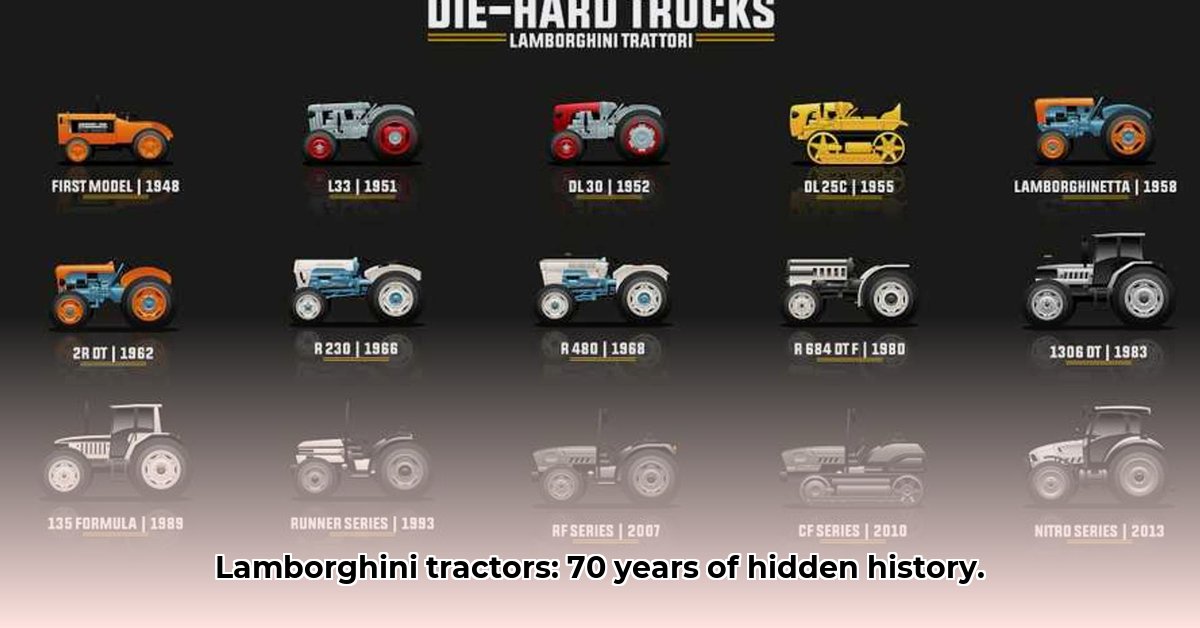
From Post-War Scraps to Global Agricultural Leader: The Lamborghini Tractor Story
The Lamborghini name conjures images of sleek, powerful supercars. But few know the brand's equally impressive history in agricultural machinery. For 70 years, Lamborghini has been a quiet force, revolutionizing farming with innovative tractors. This isn't just a story of powerful engines and sleek designs; it's a captivating tale of ingenuity, resilience, and a relentless pursuit of agricultural advancement.
Ferruccio Lamborghini's journey began in the ashes of post-World War II Italy. In 1948, amidst the widespread devastation, he saw an opportunity. Using repurposed war materials, he crafted his first tractors – functional, robust tools designed to help farmers rebuild their lives. These weren't luxury machines; they were practical workhorses, a testament to Lamborghini's resourcefulness and entrepreneurial spirit. This early focus on practicality laid the foundation for his future success. Did this resourceful approach to initial production contribute to Lamborghini's later emphasis on innovation? The answer is resounding yes. For more on early tractor innovations, see this site on vintage tractor history.
Government Policy & Market Expansion: A Turning Point
The Italian government's 1952 Fanfani Law proved pivotal. This legislation offered financial incentives to farmers purchasing Italian-made agricultural equipment, creating a surge in demand. Lamborghini, prepared for this opportunity, rapidly expanded production, transforming a small workshop into a significant player in the agricultural machinery market. This highlights the critical interplay between government policy and entrepreneurial success in shaping industrial growth. How did this policy shift change the trajectory of Lamborghini's business? It propelled them from a small operation to a major contender.
Technological Innovations: Shaping the Future of Farming
Lamborghini's commitment to innovation wasn't merely about building machines; it was about making them better. Early models featured advancements such as improved fuel systems for greater efficiency. Technological leaps continued with the introduction of synchronized gearboxes and, later, electronically controlled injection systems—features considered cutting-edge in their time. These were not incremental changes; they represented significant steps forward, allowing farmers to work faster, more efficiently, and with less effort. This relentless pursuit of improvement is a key element in Lamborghini's enduring success. What was the impact of these technological advancements on farming practices? Farmers experienced increased productivity and reduced operating costs.
Design Evolution: From Function to Form
The design language of Lamborghini tractors evolved dramatically over time. Early models, such as the "Carioca," were purely functional. Yet, as the brand progressed, designs became more refined, boasting increased power and a growing aesthetic sophistication. The Nitro series serves as a prime example of this design evolution, showcasing a blend of practicality and style. This transition demonstrates Lamborghini's dedication to quality and the creation of machines which are both effective and visually appealing. How did this design evolution strengthen Lamborghini's brand identity? It signified a commitment to quality and innovation.
A Legacy of Innovation: More Than Just Tractors
The Lamborghini tractor story transcends mere technological progress. It embodies entrepreneurial vision, strategic adaptability, and an unwavering dedication to excellence. The company's legacy extends far beyond individual models; it encompasses a profound influence on global agricultural practices. Lamborghini's success serves as a compelling case study on how innovation, coupled with strategic responses to market forces, can create a lasting impact. What were the key factors contributing to Lamborghini's enduring success? A combination of innovation, adaptation, and unrelenting commitment to quality.
Lamborghini Tractor Fuel Efficiency: A Comparative Analysis
While Lamborghini tractors are renowned for high performance, comparative data on fuel efficiency across models is limited. This makes direct comparisons difficult. However, the integration of precision farming technologies in later models, such as GPS-guided systems and optimized fertilizer application, contributes to substantial resource savings, even if precise fuel consumption figures remain elusive.
Key Takeaways:
- Lamborghini's commitment to high-performance engineering results in powerful but potentially fuel-intensive machines.
- Later model years incorporate sustainability features such as precision farming technologies that impact fuel efficiency positively.
- A lack of readily available, standardized data on fuel economy makes direct comparison across models and competitors challenging.
The Lamborghini tractor story is a testament to innovation and resilience. While challenges persist, the brand's commitment to technological advancement and sustainability positions it for continued success in the evolving landscape of modern agriculture.